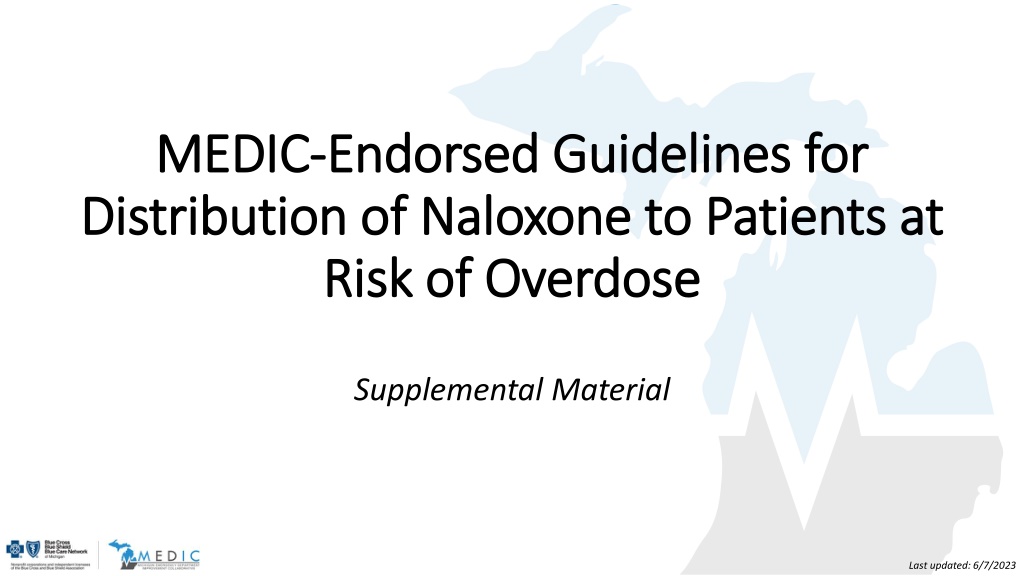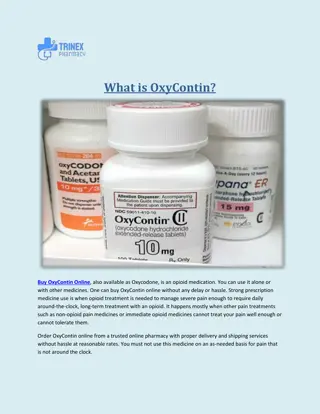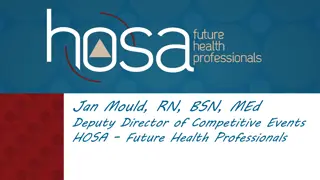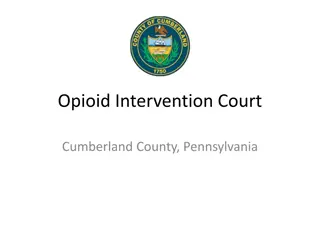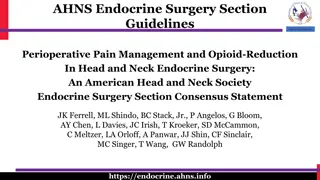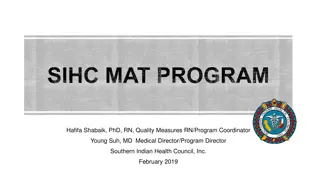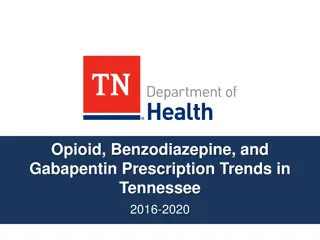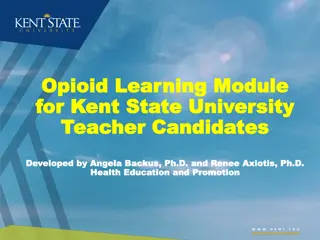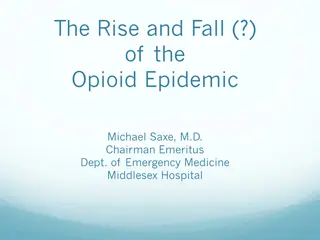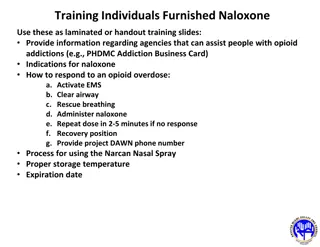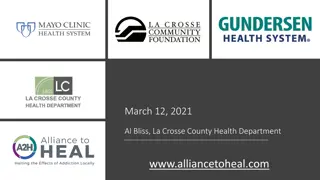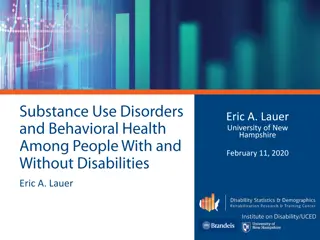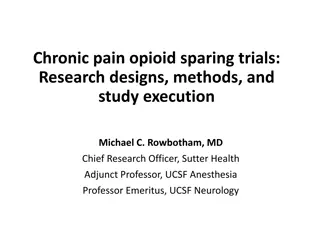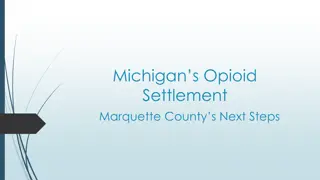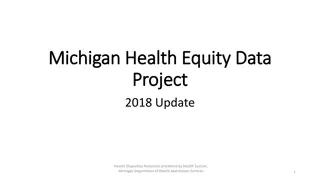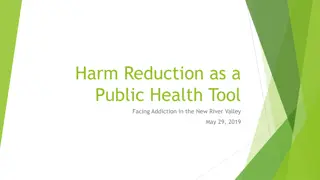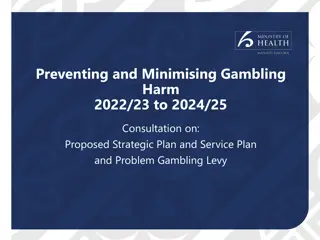Understanding Opioid Epidemic Impact & Harm Reduction in Michigan
The Michigan Emergency Department Improvement Collaborative (MEDIC) works to improve emergency care quality, with a focus on opioid overdose. Over 3,000 Michiganders died from opioid overdose in 2021, exceeding motor vehicle-related deaths. Harm reduction strategies, like distributing naloxone in EDs, aim to reduce opioid-related harm by identifying at-risk individuals and promoting recovery support.
Download Presentation

Please find below an Image/Link to download the presentation.
The content on the website is provided AS IS for your information and personal use only. It may not be sold, licensed, or shared on other websites without obtaining consent from the author. Download presentation by click this link. If you encounter any issues during the download, it is possible that the publisher has removed the file from their server.
E N D
Presentation Transcript
MEDIC MEDIC- -Endorsed Guidelines for Endorsed Guidelines for Distribution of Naloxone to Patients at Distribution of Naloxone to Patients at Risk of Overdose Risk of Overdose Supplemental Material Last updated: 6/7/2023
What is MEDIC? The Michigan Emergency Department Improvement Collaborative (MEDIC) was launched in 2015 as an emergency physician-led quality improvement Collaborative comprised of hospitals across Michigan. MEDIC partners with emergency physicians who work together to collect and analyze data, identify best practices based on medical evidence, and improve collective performance. Participating EDs submit data to a clinical registry maintained by the MEDIC Coordinating Center. Support for MEDIC is provided by Blue Cross Blue Shield of Michigan and Blue Care Network within the BCBSM Value Partnerships program.
Why quality improvement for the ED care of patients with opioid use disorder? Opioids have killed more than 1 million people since 20001 EDs are key access points to the health system 1 out of every 80 ED visits were related to opioids2 o 27.5% for overdose These visits represent about $5 billion in medical care bills annually in the ED2 Every day emergency physicians see the devastating consequences of the opioid epidemic. 3 1CDC, National Center for Health Statistics, Drug Overdose Deaths. Accessed June 2023: https://www.cdc.gov/nchs/nvss/drug-overdose-deaths.htm 2Langabeer JR, et al. Prevalence and Charges of Opioid-Related Visits to US Emergency Departments. Drug and Alcohol Dependence, 2021;221:108568. doi: 10.1016/j.drugalcdep.2021.108568. 3American College of Emergency Physicians, Opioid Resources. Accessed June 2023: https://www.acep.org/by-medical-focus/mental-health-and-substanc-use- disorders/opioids
What is the impact of the opioid epidemic on the state of Michigan? >3,000 Michiganders died from an overdose in 2021 More than twice as many Michiganders died from overdose than from motor vehicles >31,000 Michiganders experienced an ED visit for a non-fatal overdose in 2021 Michigan State Government Opioid Resources, Michigan Overdose Data to Action Dashboard. Accessed June 2023: https://www.michigan.gov/opioids/category-data
What is harm reduction and why should we implement this approach for opioids in the ED? Harm reduction is a public health approach that aims to reduce the harms associated with a health risk behavior1 EDs can identify people at risk for overdose, intervene to reduce future harm, and remove barriers for treatment and recovery support Naloxone, or Narcan, the opioid reversal agent, is an important harm reduction intervention for opioids The naloxone prescribing rate (7.4%) after ED visits for nonfatal overdose was substantially lower than the epinephrine prescribing rate (48.9%) after ED visits for anaphylaxis 1Macias-Konstantopoulos W, et al. Between Emergency Department Visits: The Role of Harm Reduction Programs in Mitigating the Harms Associated With Injection Drug Use. Annals of Emergency Medicine, 2021;77(5):479-492. doi: 10.1016/j.annemergmed.2020.11.008. 2Chua K-P, et al. Naloxone and Buprenorphine Prescribing Following US Emergency Department Visits for Suspected Opioid Overdose: August 2019 to April 2021. Annals of Emergency Medicine, 2022;79(3):225-236. doi: 10.1016/j.annemergmed.2021.10.005.
Why should we implement naloxone distribution for harm reduction in the ED? ED distribution of point-of-care naloxone is the gold standard for eliminating barriers to access to this life-saving medication GOAL Patients discharged from the ED after a nonfatal opioid overdose have a high short-term mortality risk1 1.1% died within 1 month, 5.5% died within 1 year Strong correlation between availability of naloxone in a community and opioid overdose deaths2 RATIONALE Bystanders were present in more than half of opioid overdose deaths3 With the right tools, bystanders can act to prevent overdose deaths Naloxone may not only save your patient s life, but their friends or community members An endorsed best practice by the American College of Emergency Physicians4 1Weiner SG, et al. One-Year Mortality of Patients After Emergency Department Treatment for Nonfatal Opioid Overdose. Annals of Emergency Medicine, 2020;75(1):13-17. doi: 10.1016/j.annemergmed.2019.04.020. 2Wally AY, et al. Opioid Overdose Rates and Implementation of Overdose Education and Nasal Naloxone Distribution in Massachusetts: Interrupted Time Series Analysis. BMJ, 2013; 346:f174. doi: 10.1136/bmj.f174. LITERATURE 3Kim HS, et al. Unintentional Opioid Overdose Death Characteristics in Illinois Before and During the COVID-19 Era, 2017 to 2020. JAMA Health Forum, 2021; 2(11):e213699. doi:10.1001/jamahealthforum.2021.3699. 4American College of Emergency Physicians, Naloxone Access and Utilization for Suspected Opioid Overdoses. Accessed June 2023: https://www.acep.org/siteassets/new-pdfs/policy-statements/naloxone-access-and-utilization-for-suspected-opioid-overdoses.pdf
Are ED-based point-of-care naloxone distribution programs feasible? To standardize ED practices to consistently offer naloxone at the point-of-care for all patients at risk of future opioid overdose GOAL Many EDs in a variety of settings, environments, and resources in Michigan and across the US have successfully implemented naloxone distribution programs1,2,3,4 RATIONALE 1Gunn AH, et al. The Emergency Department as an Opportunity for Naloxone Distribution. Western Journal of Emergency Medicine, 2018; 19(6):1036- 1042. doi: 10.5811/westjem.2018.8.38829. 2Samuels EA, et al. Adoption and Utilization of an Emergency Department Naloxone Distribution and Peer Recovery Coach Consultation Program. Academic Emergency Medicine, 2019; 26(2):160-173. doi: 10.1111/acem.13545. 3Eswaran V, et al. Take-Home Naloxone Program Implementation: Lessons Learned from Seven Chicago-Area Hospitals. Annals of Emergency Medicine, 2020; 76(3):318-327. doi: 10.1016/j.annemergmed.2020.02.013. 4Dora-Laskey A, et al. Piloting a statewide emergency department take-home naloxone program: improving the quality of care for patients at risk of opioid overdose. Academic Emergency Medicine. 2021:29(4):442-455. doi: 10.1111/acem.14435. LITERATURE
Who in the ED should get naloxone for discharge? GOAL Describe the population at risk of harm from future overdose who could benefit from having naloxone Always offer these patients take-home naloxone during their ED visit: Opioid overdose Receiving or seeking treatment for opioid use disorder (OUD) Opioid withdrawal Strongly consider offering these patients take-home naloxone during their ED visit: Recent loss of opioid tolerance Including recent release from incarceration or other controlled setting History of prior overdose, opioid use, or OUD Use of illegal drugs that could contain illicit synthetic opioid like fentanyl New or chronic prescription for opioids Especially if taking higher dosages of opioids ( 50 morphine milligram equivalents (MME)/day) Prescription for benzodiazepine AND opioid Any of the below in combination with any of the above: History of mental health disorder, suicide risk History of non-opioid substance use disorder (SUD) including alcohol, legal or illegal drug use History of conditions such as chronic obstructive pulmonary disease (COPD) or obstructive sleep apnea, or reduced kidney or liver function Age 65+ years DEFINITION CDC, Fact Sheet: Emergency Department, When to Offer Naloxone to Patients in the Emergency Department. Accessed June 2023. https://www.cdc.gov/opioids/naloxone/ LITERATURE
Why to avoid stigma for opioid harm reduction in the ED? Talk to and educate patients using empathetic, person-first language This change shows that a person has a problem, rather than is the problem DO s DON Ts I care about your safety Naloxone saves lives What s your plan when you leave here? Naloxone is a lifesaver, like having a fire extinguisher Share with your family and friends where you keep naloxone and how to administer it Opioid use disorder, substance use disorder, addiction Substance abuse, drug habit, addictive disorder Addict, junkie, drug abuser, druggie, alcoholic Person who uses drugs Person in recovery, in remission Clean, staying clean Positive drug test, testing negative for drug use Dirty drug test, clean drug screen Medications for opioid use disorder Medication-assisted treatment National Institute on Drug Abuse, Words Matter: Terms to Use and Avoid When Talking About Addiction. Accessed June 2023: https://nida.nih.gov/research- topics/addiction-science/words-matter-preferred-language-talking-about-addiction
Key References American College of Emergency Physicians, Naloxone Access and Utilization for Suspected Opioid Overdoses. Accessed June 2023: https://www.acep.org/siteassets/new- pdfs/policy-statements/naloxone-access-and-utilization-for-suspected-opioid-overdoses.pdf American College of Emergency Physicians, Opioid Resources. Accessed June 2023: https://www.acep.org/by-medical-focus/mental-health-and-substanc-use-disorders/opioids CDC, Fact Sheet: Emergency Department, When to Offer Naloxone to Patients in the Emergency Department. Accessed June 2023. https://www.cdc.gov/opioids/naloxone/ CDC, National Center for Health Statistics, Drug Overdose Deaths. Accessed June 2023: https://www.cdc.gov/nchs/nvss/drug-overdose-deaths.htm Chua K-P, et al. Naloxone and Buprenorphine Prescribing Following US Emergency Department Visits for Suspected Opioid Overdose: August 2019 to April 2021. Annals of Emergency Medicine, 2022;79(3):225-236. doi: 10.1016/j.annemergmed.2021.10.005. Dora-Laskey A, et al. Piloting a statewide emergency department take-home naloxone program: improving the quality of care for patients at risk of opioid overdose. Academic Emergency Medicine. 2021:29(4):442-455. doi: 10.1111/acem.14435. Eswaran V, et al. Take-Home Naloxone Program Implementation: Lessons Learned from Seven Chicago-Area Hospitals. Annals of Emergency Medicine, 2020; 76(3):318-327. doi: 10.1016/j.annemergmed.2020.02.013. Gunn AH, et al. The Emergency Department as an Opportunity for Naloxone Distribution. Western Journal of Emergency Medicine, 2018; 19(6):1036-1042. doi: 10.5811/westjem.2018.8.38829. Kim HS, et al. Unintentional Opioid Overdose Death Characteristics in Illinois Before and During the COVID-19 Era, 2017 to 2020. JAMA Health Forum, 2021; 2(11):e213699. doi:10.1001/jamahealthforum.2021.3699. Langabeer JR, et al. Prevalence and Charges of Opioid-Related Visits to US Emergency Departments. Drug and Alcohol Dependence, 2021;221:108568. doi: 10.1016/j.drugalcdep.2021.108568. Macias-Konstantopoulos W, et al. Between Emergency Department Visits: The Role of Harm Reduction Programs in Mitigating the Harms Associated With Injection Drug Use. Annals of Emergency Medicine, 2021;77(5):479-492. doi: 10.1016/j.annemergmed.2020.11.008. Michigan State Government Opioid Resources, Michigan Overdose Data to Action Dashboard. Accessed June 2023: https://www.michigan.gov/opioids/category-data National Institute on Drug Abuse, Words Matter: Terms to Use and Avoid When Talking About Addiction. Accessed June 2023: https://nida.nih.gov/research-topics/addiction- science/words-matter-preferred-language-talking-about-addiction Samuels EA, et al. Adoption and Utilization of an Emergency Department Naloxone Distribution and Peer Recovery Coach Consultation Program. Academic Emergency Medicine, 2019; 26(2):160-173. doi: 10.1111/acem.13545. Wally AY, et al. Opioid Overdose Rates and Implementation of Overdose Education and Nasal Naloxone Distribution in Massachusetts: Interrupted Time Series Analysis. BMJ, 2013; 346:f174. doi: 10.1136/bmj.f174. Weiner SG, et al. One-Year Mortality of Patients After Emergency Department Treatment for Nonfatal Opioid Overdose. Annals of Emergency Medicine, 2020;75(1):13-17. doi: 10.1016/j.annemergmed.2019.04.020.
